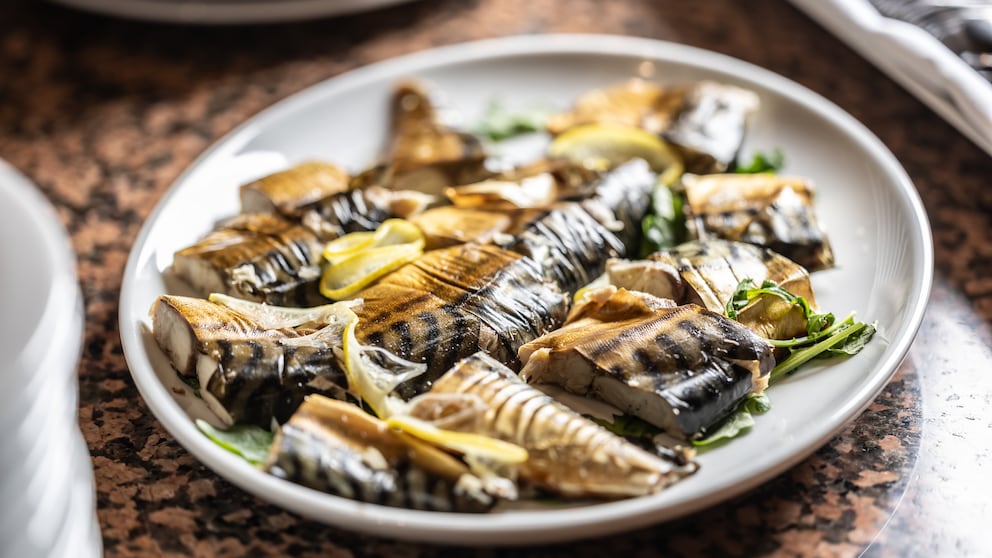February 21, 2025, 2:23 pm | Read time: 5 minutes
Pink salmon is the favorite edible fish among Germans. Lagging far behind in the rankings is mackerel. Quite wrongly, according to our nutrition expert. He explained to FITBOOK what makes mackerel one of the healthiest edible fish.
Mackerel is a fatty marine fish. Munich nutritionist Prof. Dr. Nicolai Worm explains to FITBOOK editor Martin Lewicki why mackerel is so particularly healthy. A little spoiler: it’s not just because of the abundant omega-3 fatty acids it contains
Overview
The Big 5 When Eating Fish
When fish is served in this country, it is usually salmon. According to the German Fish Information Center, it accounts for almost 20 percent of fish consumption in Germany. It is followed by Alaska pollack, tuna, bonito, herring, and shrimp — with mackerel trailing significantly behind.1
What Makes Mackerel So Healthy?
From a health perspective, the 30 to 50-centimeter-long schooling fish is quite wrongly disdained, says nutritionist Prof. Dr. Nicolai Worm: “Mackerel is a fatty marine fish, so it has a lot of healthy omega-3 fatty acids. The protein is high quality, and it contains an extremely high amount of vitamin D as well as various other vitamins and minerals.” Its vitamin A content is particularly high, which is important for healthy eyes, skin, and mucous membranes. With a protein content of around 20 percent, mackerel is also an excellent source of protein. This makes it particularly interesting for athletes.
According to Prof. Worm, mackerel, wild salmon, and herring are the fish richest in omega-3. In the case of salmon, it is primarily whether it is ‘wild’ that counts. Farmed salmon are often fed low-quality grain feed and do not contain as many omega-3 fatty acids as salmon from wild waters.
However, the proportion of omega-3 fatty acids in mackerel also varies greatly. Depending on the season, mackerel can have between three and 30 percent fat content. It is at its fattest in the fall, when it has prepared for wintering in deep waters. Moreover, it is leanest in early summer, directly after spawning.
How Can You Tell if a Mackerel Is Fatty?
With whole fish, you can tell by the bulging volume of the 30- to 50-centimeter specimens. Above all, you can also taste it. Prof. Worm: “It tastes oilier, greasier. You can tell the difference in consistency between low-fat and high-fat quark, for example.” It is difficult to tell the difference with processed fish, such as canned fish.
Isn’t Fatty Mackerel a Calorie Bomb?
At first glance, the high-fat content makes mackerel high in calories. In grilled form, for example, fat makes up 18 percent – this can, of course, vary depending on how it is prepared.2 According to the nutrition expert, however, there is something very important to bear in mind. When discussing calories, it is important to remember that “a fatty but protein-rich food such as mackerel keeps you full for longer and may help you to have eaten fewer calories at the end of the day.” Calories should not just be seen as calories without also assessing their satiating effect. Fatty foods are more filling and help you to eat less overall.
What Is the Best Way to Eat Mackerel?
Prof. Worm always prefers fresh food and often eats “Steckerlfisch” mackerel — skewered and grilled on a stick. With packaged food, you just don’t know which particles are released into the food — regardless of whether it’s plastic packaging or canned aluminum. Of course, packaging cannot always be avoided, but fresh and unpackaged food should generally be preferred, even when it comes to fish.
What Should You Look Out for When Buying Mackerel?
As with all marine fish and seafood, you should also pay attention to sustainable fishing when buying mackerel. The MSC seal of the Marine Stewardship Council is particularly helpful. This is only awarded if the stock of the fish in question is in good condition, the impact of fishing on the ecosystem is not too great, and there is an appropriate response to stock fluctuations. Only if a fishery has proven these criteria in an intensive testing procedure is it MSC-certified.
For example, North-East Atlantic mackerel fishermen from Ireland, Denmark, Sweden, the UK, the Netherlands, Norway, Iceland, and the Faroe Islands lost the blue MSC label for sustainable fishing at the beginning of 2019. “According to recent data from the International Council for the Exploration of the Sea (ICES), the mackerel stock in the North-East Atlantic has fallen below its minimum sustainable stock size,” the MSC explains its decision.3

Ideal for strength athletes 3 Protein-Rich Air Fryer Snacks

Nutrition Expert Explains Why Quark with Linseed Oil Can Help You Lose Weight

Nutrients 5 nuts that can help you lose weight
What if I Don’t Like or Can’t Regularly Eat Sea Fish?
For anyone who does not like sea fish or does not eat it regularly, the expert recommends taking long-chain, unsaturated omega-3 fatty acids from fish oil or algae oil supplements. This should be at least one gram of eicosapentaenoic and docosahexaenoic acid (EPA + DHA).

